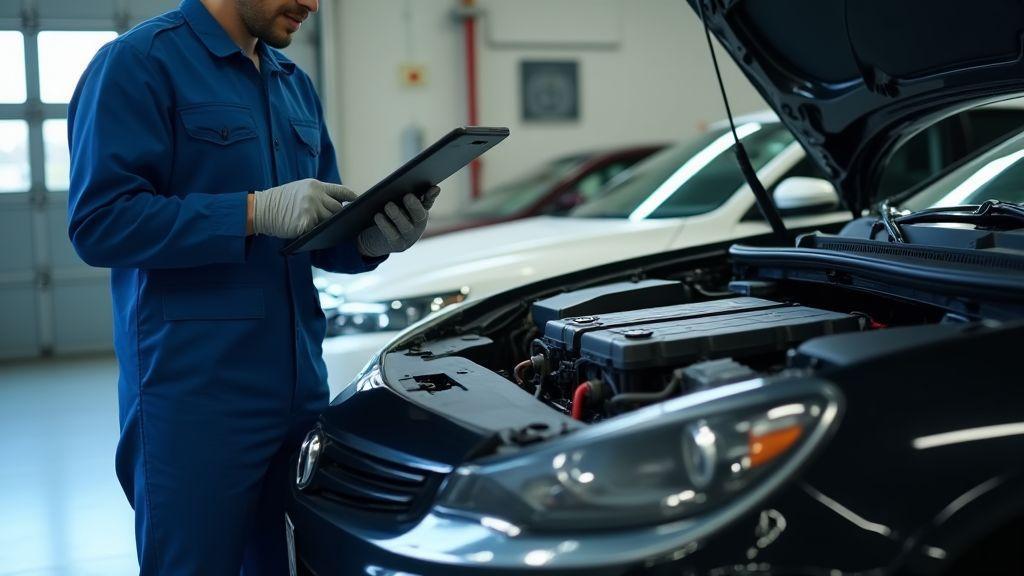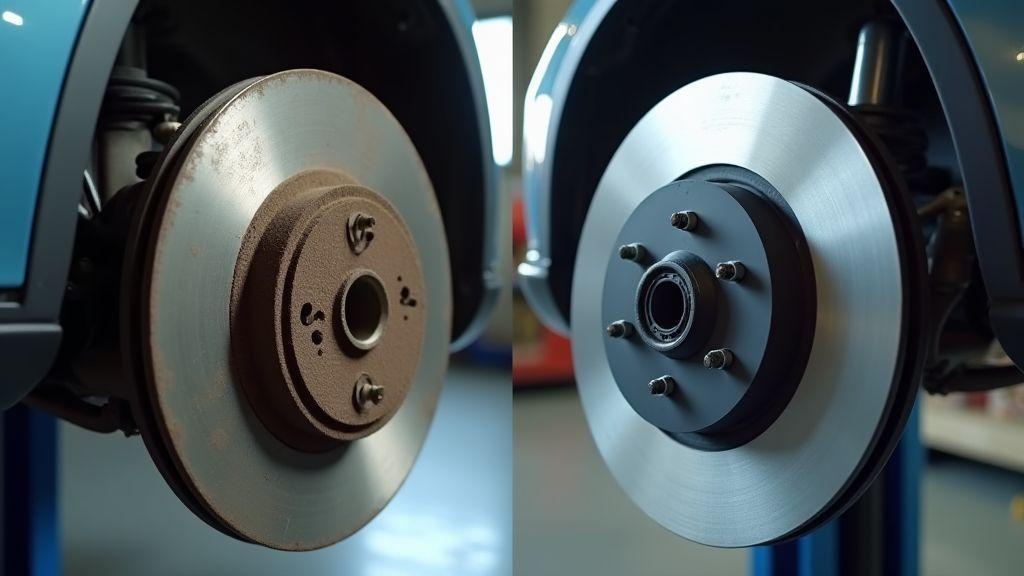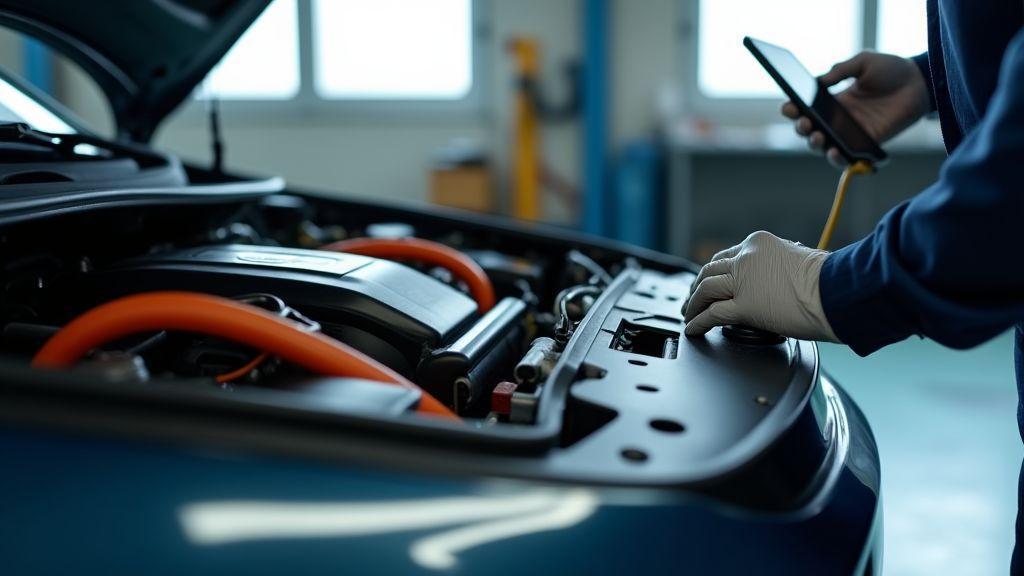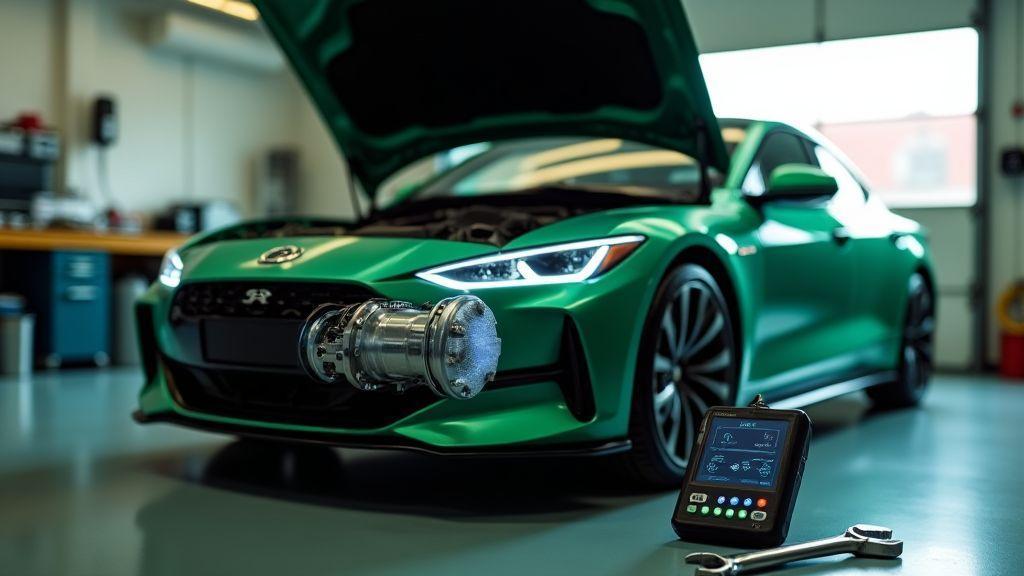Maintenance Tips for Hybrid Cars — What’s Different?
You will get clear, practical guidance to keep your hybrid running its best. Focus on battery care to extend lifespan: check state of charge and avoid deep discharge, shield the pack from extreme heat or cold, and follow your owner’s manual. Keep up with scheduled service and hybrid-specific inspections. Remember regenerative braking cuts pad wear but still needs brake fluid and parking brake checks. Watch cooling for the inverter and battery. Stay current on oil, plugs, and belts with hybrid-aware diagnostics. Manage tires and drive gently. Do simple daily checks to catch problems early.
Key Takeaway
- Have your hybrid battery checked by a trained technician.
- Use the right oil and change it as your manual says.
- Watch your brakes and avoid hard stops to make pads last longer.
- Keep your cooling system clean to protect the battery and electrical parts.
- Take your car to your dealer or a certified shop for hybrid repairs — or contact our team for local recommendations.

Maintenance Tips for Hybrid Cars — What’s Different? Battery care to extend hybrid battery lifespan
Hybrid batteries matter more than most people realize. You’ll still handle oil changes, brakes, and tires like a regular car, but the battery adds another chapter to your maintenance book. Treat the battery as a living part: its charge level, temperature exposure, and usage pattern all affect how long it lasts. Small daily choices—how you park, how often you plug in (if plug-in hybrid), and how you drive in traffic—add up over years.
Expect different service intervals and warning signs. Your owner’s manual will list hybrid-specific checks and software updates that a gas-only car doesn’t need. Dealers or qualified hybrid shops will monitor battery health with diagnostics your regular shop might not have. Plan for occasional battery system scans and software updates; they cost less than a surprise replacement and keep the battery working efficiently.
Check your battery state of charge and follow the owner’s manual
You should check your battery state of charge (SOC) regularly, especially before long trips or storage. The SOC window that’s healthiest for the pack depends on the model — many hybrids perform best roughly between 20% and 80% SOC; plug-in hybrids have different guidelines. Your manual gives the exact target ranges and charging habits for your car. Follow those numbers—manufacturers set them for a reason.
If you drive a plug-in hybrid, monitor charging cycles and avoid topping to 100% every time unless you need maximum range; see Plug-in charging and battery care tips. Frequent full charges and deep discharges create extra stress. For non-plug-ins, let the management system do its job but pay attention to dashboard alerts. If the system flags a low or high SOC repeatedly, get a diagnostic check.
- Check SOC on your dash before long storage or trips.
- Read the owner’s manual for model-specific SOC ranges.
- Use recommended charging habits: avoid constant 100% charge if not needed.
- Schedule diagnostics if alerts repeat.
Avoid deep discharge and protect your battery from extreme heat or cold
Deep discharges and extreme temperatures speed up wear. If the battery falls near empty or stays at very low charge for long stretches, chemical wear accelerates. In summer, heat can dry and degrade cells; in winter, cold reduces performance and can cause repeated strain when you try to get range back. Keep your car in a garage when possible and avoid letting the battery sit fully empty for days.
Modern hybrids have thermal management and safeguards, but you can help. Park in shade or a covered spot in summer, and use garage heat or insulated covers in winter if you’ll store the car. If you live in a place with large seasonal swings, plan maintenance checks before and after the harsh season. A quick battery health scan after a long hot summer or cold winter can catch trouble before it becomes expensive.
| Condition | Recommended SOC for Storage | Temperature to Avoid | Quick Action |
|---|---|---|---|
| Short-term daily use | 30–80% | Above 120°F / Below 14°F | Park shaded or warmed; monitor SOC |
| Long-term storage (weeks) | ~50% | Avoid extremes; 40–86°F pref. | Charge to mid-level, disconnect 12V if manual |
| Extreme weather exposure | Keep mid-range | Above 120°F or below 0°F | Move to climate-controlled spot ASAP |
Tips for long-term storage and regular use
For long-term storage, leave the hybrid at a mid-level state of charge (around 40–60%), disconnect accessories that draw power, and start or run the car periodically per the manual. For daily use, keep charging habits steady, avoid constant 100% fills unless needed, and park where temperature swings are mild. These simple actions cut stress on the pack and add miles to its life.
Follow scheduled service intervals for hybrids to protect systems
You want your hybrid to run like clockwork. Hybrids combine a gasoline engine, electric motor, battery pack, and complex electronics. Following the factory service schedule protects each part. Missed services let small problems grow into big, costly repairs — a dead high-voltage battery or seized inverter can wipe out savings fast.
Stick to the intervals in your owner’s manual for oil changes, coolant swaps, and brake checks. Hybrid systems often use different fluids and filters than conventional cars. Technicians may swap hybrid-specific coolant or check battery coolant paths; skipping these can shorten component life and hurt fuel economy.
Routine service also prevents secondary issues. For example, worn brake pads affect regenerative braking behavior and can overload the friction brakes. By following the schedule you keep the whole system balanced, save money over time, and maintain the quiet, efficient drive you bought.
Know your hybrid’s recommended service schedule and mileage checks
Every hybrid model has its own rhythm. Your owner’s manual lists time- and mileage-based checks. Typical items include oil and filter changes every 5,000–10,000 miles, brake inspections at regular intervals, and a battery health check at intervals set by the maker. Use those benchmarks as your roadmap. For general advice on keeping vehicles tuned to protect efficiency, see Maintenance to protect hybrid systems and fuel economy.
Below is a simple example to show common service items and rough intervals — always follow your manual.
| Service item | Typical interval (example) | Why it matters |
|---|---|---|
| Engine oil & filter | 5,000–10,000 miles | Keeps engine lubricated; hybrids still need healthy engines |
| Brake inspection | Every service / ~6,000–10,000 miles | Checks regenerative braking and pad wear |
| High-voltage battery check | 30,000–60,000 miles | Tracks capacity and cooling system performance |
| Coolant for inverter/battery | 60,000–100,000 miles or per manual | Prevents overheating of electrical components |
| Software updates | At dealer visits or as released | Improves efficiency and system management |
Have technicians perform hybrid-specific inspections at each service
Ask your shop to run hybrid-specific checks every time you bring the car in. That includes scanning hybrid control modules, testing battery state of charge and cooling, and inspecting high-voltage wiring for damage. These checks catch issues before they cascade into bigger failures.
Use a technician trained on hybrids. They know safety steps like de-energizing systems and where service plugs live. A good tech will also note firmware updates and look for signs of overheating or fluid contamination — plain talk that saves you from surprises down the road.
How to track your hybrid service records
Keep simple, tidy records so you can prove regular care and spot trends. Keep paper receipts, scan them to a folder, or use a service app. Track date, mileage, services done, and technician notes.
- Create a digital folder or app entry for each service visit.
- Save or photograph every receipt and add a one-line note of any recommendations.
- Review records before each visit to remind the tech of past issues.

How regenerative braking changes brake wear and maintenance
Regenerative braking shifts much of the slowing work from your pads and rotors to the electric motor. That cuts pad wear and stretches how long the parts last. You’ll still use the friction brakes for hard stops, low-speed maneuvers, and when the battery is full, so wear never drops to zero. Learn more about the technical principles at How regenerative braking reduces brake wear.
Maintenance Tips for Hybrid Cars — What’s Different? Mostly, you can expect longer pad life and fewer rotor replacements. But the trade-off is less frequent use of some parts, which can lead to rust, sticking, and other age-related issues you might not expect if you only watch mileage.
Think of regenerative braking as a part-time worker who saves you effort but needs regular check-ins. Your technician should inspect the whole brake system the same way they would on a traditional car: pads, rotors, calipers, fluid, lines, and the parking brake. Regular inspections catch hidden problems before they become big bills.
Understand that regenerative braking reduces pad wear but still needs checks
Regeneration takes the brunt of everyday slowing. You’ll see lighter pad wear and fewer pad swaps, but don’t skip checks.
Pads and calipers can still wear unevenly or pick up grit that causes noise or vibration. Sensors, wear indicators, and ABS parts still need testing. Have your brakes checked on schedule, not just when you hear a squeal.
Monitor brake fluid, lines, and the parking brake for safe operation
Brake fluid is hygroscopic — it absorbs water over time and loses braking performance. Even with less pad use, fluid should be checked and replaced per the maker’s schedule to avoid corrosion inside lines and calipers.
The parking brake may see less action and can seize from rust or dirt. Exercise it regularly and have lines and hoses inspected for cracks or leaks. A quick functional test at home once a month can save you a tow.
- Check brake fluid level and color every service.
- Inspect rubber lines for cracks or swelling.
- Engage the parking brake periodically to keep parts moving.
- Listen and feel for vibration or pulling when braking.
Keep hybrid cooling systems and inverters healthy with routine checks
Hybrid cooling systems and inverters keep your battery and power electronics working without overheating. Think of them as your car’s air conditioner for the electric parts. If you skip checks, small leaks or a failing fan can turn into a dead battery or an expensive inverter replacement. Maintenance Tips for Hybrid Cars — What’s Different? is that the electric side has its own cooling loop and warning signs that look different from a gas-only car.
Do a few simple checks often. Look at coolant levels, listen for cooling fans after a drive, and watch the dash for inverter or battery alerts. A short check once a month can catch slow leaks or low coolant. Track what you find in a simple log on your phone so you spot trends before they become problems.
When you see a warning light or smell something odd, act fast. For safety guidance on EV systems and cooling responses, consult Electric vehicle safety and cooling systems. A burned electrical smell or a loud fan run can mean the inverter is working too hard. Quick action—pull over safely, let the system cool, and contact a qualified hybrid technician—can save you thousands. Regular checks keep you out of that emergency lane.
- Quick routine steps to follow monthly:
- Check coolant reservoirs for proper level and clarity.
- Look under the car for fresh coolant drips.
- Start the car and listen for cooling fan operation.
- Note any warning lights, smells, or unusual noises.
- Schedule professional service if any item looks off.
| Component | Recommended check interval |
|---|---|
| Battery coolant reservoir | Monthly |
| Inverter coolant reservoir | Monthly |
| Coolant hoses and clamps | Every 6 months |
| Cooling fans and wiring | Every 6 months |
| Filters (if applicable) | Annually or per manual |
Check coolant levels for battery and inverter cooling regularly
Coolant keeps the battery and inverter at a safe temperature. Low levels let temperatures climb fast. Check when the car is cool and parked on level ground. Open the small translucent reservoir and read the marks. Top off with the fluid type your manual names. Don’t mix different coolant types. If levels drop again after a top-up, look for a leak and get the car checked.
Watch for signs of inverter overheating and unusual smells or noises
You will often get a warning light before a serious issue. But smells and sounds are big clues too. A sharp electrical or burnt smell, a high-pitched whine, or sudden loss of electric drive all point to trouble. These signs mean the inverter or its cooling is under stress.
If you notice any of these, stop driving when it’s safe and let the system cool. Restart only if the warning clears and the smell is gone. If problems return, call a qualified hybrid technician. Driving on a stressed inverter is like running your phone on full blast until the battery dies—costly and avoidable.
Scheduled checks for coolant hoses, fans, and filters
Hoses can crack, clamps loosen, and fans can fail; check them every six months or at your service interval. Look for soft or swollen hoses, tight clamps, and clean fan blades with no wobble. Replace worn hoses and clean or replace filters on schedule so air and coolant flow stay strong.

Engine upkeep and diagnostic procedures for hybrid systems
Hybrids mix an electric motor with a gas engine, so your upkeep has two sides. You still deal with oil, filters, spark plugs, belts, and cooling. But you also watch battery state, inverter temps, and high-voltage wiring. If you search “Maintenance Tips for Hybrid Cars — What’s Different?” you’ll find the same basic service items plus extra checks for the electric parts.
Treat the engine like a partner with the electric system. The gas engine may run less, but when it runs it can work harder in short bursts. That changes how oil breaks down and how spark plugs wear. Pay attention to service intervals in your owner’s manual, and log each visit so you know what was done and when.
Diagnostics are part of routine care now. A simple check can catch a failing sensor or a cooling issue before it becomes a big bill. Stay on top of software updates and let a hybrid-capable shop verify battery health and inverter cooling during major services.
Keep up with oil changes, spark plug checks, and belt inspections
Oil still matters. Even if the engine idles less, heat cycles and stop-start use can age oil faster in some hybrids. Use the oil grade the maker calls for. Change it at the listed interval or sooner if you drive in hot weather or do lots of short trips. Fresh oil keeps moving parts lubricated and helps the engine start and stop smoothly.
Spark plugs see more starts in many hybrids. That means they can foul or gap sooner. Inspect and replace them at the maker’s interval. A bad plug makes the engine run rough and sips more fuel. Belts—both accessory and timing—should be checked for cracks and wear. A snapped belt can strand you and damage the engine.
Use hybrid-capable diagnostic tools to read error codes and system status
Not every scan tool reads hybrid modules. You want a scanner that shows battery pack data, inverter faults, and hybrid system codes. Basic OBD-II readers show engine codes, but a hybrid-capable tool reads high-voltage system messages. If you get a code, don’t panic. A tool gives you a starting point.
Follow a simple scan routine when you check codes:
- Plug the scanner into the OBD-II port and turn the ignition to the accessory position.
- Read stored and pending codes and capture live data like battery voltage and inverter temp.
- Research the code in the vehicle’s service info or a trusted database.
- Clear codes only after fixing the root cause, then recheck to confirm the fix.
How to read hybrid system warnings and act quickly
Hybrid warnings come in flavors: info lights, amber warnings, and red stop indicators. An amber or service light means you should book a check soon. A red light or a message to stop driving means pull over safely, turn off the vehicle, and call for help. Keep a basic safety habit: move to a safe spot, use hazard lights, and avoid touching high-voltage parts.
| Warning symbol | What it usually means | Immediate action |
|---|---|---|
| Battery icon or “HV system” | Hybrid battery or BMS fault | Pull over when safe; restart to see if it clears; call service |
| Red triangle or STOP | Severe hybrid/inverter fault | Stop driving; power down; call roadside assistance |
| Amber engine or hybrid light | Sensor or performance issue | Schedule service; avoid heavy loads until checked |
| Coolant temp / inverter temp | Overheating of inverter/coolant system | Reduce load; pull over if temps keep rising; seek service |
Manage tires, driving habits, and small habits that extend battery life
If you search “Maintenance Tips for Hybrid Cars — What’s Different?” start here: the biggest wins come from tire care, how you drive, and small daily habits. These three areas affect battery load, fuel use, and wear on brakes and suspension. Think of them as easy levers you can pull every day to keep your hybrid running longer and saving you money.
Tires are more than rubber on the road. Proper pressure and even wear cut rolling resistance and lower how hard your electric motor must work. That saves battery energy and helps braking systems last longer. You don’t need fancy tools — a simple pressure gauge and routine checks make a big difference.
Driving style and tiny habits matter. Smooth acceleration, using regenerative braking, and limiting quick starts reduce stress on the battery and engine. Parking in shade, preconditioning the cabin while plugged in, and following the maker’s charging advice all add small gains that stack into real range and life improvements.
Keep tires properly inflated to reduce energy use and uneven wear
Low tire pressure increases rolling resistance. Your hybrid’s electric motor compensates, which eats battery charge faster and can lower your MPG. You’ll also see uneven tread wear sooner, which forces earlier replacements. A firm, correctly inflated tire keeps your hybrid efficient and safer in wet or cold conditions.
Check pressure when tires are cold, and follow the PSI on the driver door placard, not the number on the tire sidewall. Aim to check weekly or before long trips. Rotate tires per the owner’s schedule and replace when tread gets low; uneven wear often signals alignment or suspension issues that also hurt efficiency.
| Item | What to check | How often |
|---|---|---|
| Tire pressure | PSI per door placard, cold check | Weekly or before long trips |
| Tread depth | Wear bars or 2-penny test | Monthly |
| Rotation & alignment | Even wear patterns | Every 6,000–8,000 miles or per manual |
Drive gently and use regenerative braking to improve hybrid car maintenance
Gentle driving saves energy and parts. Smooth starts and steady speeds reduce load on the battery and transmission. When you accelerate slowly, the hybrid can rely more on electric power at low speeds, which lowers fuel use and heat stress on components.
Use regenerative braking to capture energy you’d otherwise lose. Learn the regen settings and use them in traffic and downhill stretches. Anticipate stops so you can coast and let regen do most of the slowing — that saves brake pads and returns energy to the battery.
Simple daily checks you can do to protect your hybrid
Spend five minutes each day to keep your hybrid healthy: glance at tire pressure, read warning lights, check fluid levels, and confirm the cabin preconditioning or charge timer is set if needed. These quick checks prevent small issues from growing and keep your car ready for the road.
- Check tire pressure and visual tread wear.
- Scan the dash for warning lights.
- Verify charge level and scheduled charging.
- Look under the car for leaks or loose parts.
- Set cabin preconditioning while plugged in if weather dictates.
FAQ: Maintenance Tips for Hybrid Cars — What’s Different?
Q: How often should I have the hybrid battery checked?
A: Follow the interval in your owner’s manual (many manufacturers recommend checks every 30,000–60,000 miles) and get a diagnostic if you see recurring SOC alerts or warning lights.
Q: Can I use a regular mechanic for hybrid service?
A: For basic items (oil, tires) a good independent shop is fine, but have hybrid-specific checks, battery scans, and inverter cooling work done by dealers or technicians trained on hybrids.
Q: Does regenerative braking eliminate brake maintenance?
A: No. Regen reduces pad wear but doesn’t remove the need for inspections, brake fluid changes, or parking brake care.
Conclusion
Your hybrid rewards steady, smart care. Follow the owner’s manual, keep up with scheduled service, and prioritize battery health—those steps save you money and headaches.
Think of battery care like tending a garden: small, regular habits—watching state of charge, avoiding deep discharge, shielding from extreme heat or cold—keep the pack healthy for years. Do the same for cooling and electronics: check coolant, listen for fan changes, and act on warning lights quickly.
Don’t ignore the basics either. Maintain oil, spark plugs, belts, and tires, use regenerative braking and gentle driving to reduce wear, and have hybrid-capable diagnostics run at intervals. Keep concise records, inspect the brakes and parking brake periodically, and store the car properly during long idle periods. These simple routines keep your hybrid humming and reliable.
Want more practical guides? Explore our home page. For site policies, read our privacy policy and terms of use.

